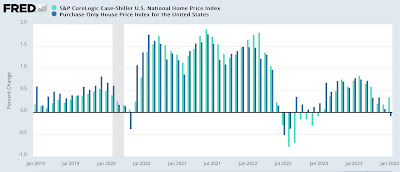Uncategorized
Repeat home sales price declined slightly in January; expect deceleration in the CPI measures of shelter to continue
– by New Deal democratAs I noted again yesterday, house prices lag home sales, which in turn lag mortgage rates. Yesterday we got the final February…

- by New Deal democrat
As I noted again yesterday, house prices lag home sales, which in turn lag mortgage rates. Yesterday we got the final February reading on sales. This morning we got the final January read on prices, for repeat sales of existing homes.
Last week’s report on existing home sales showed a sharp increase in February, a repeat of the seasonally adjusted sharp increase last February, which was almost completely taken back over the next two months. YoY sales remained down by over 3%, but the median price of an existing home remained higher by 5.7% - very much *unlike* new homes, where sales have firmed, but price remain almost 20% down from their peak.
Uncategorized
Not having job flexibility or security can leave workers feeling depressed, anxious and hopeless
The way jobs are structured affects employee mental health, an analysis of more than 18,000 workers shows.

When employees don’t have control over their work schedules, it’s not just morale that suffers – mental health takes a hit too. That’s what my colleagues and I discovered in a study recently published in the medical journal JAMA Network Open.
As a public health expert, I know that the way our jobs are designed can affect our well-being. Research has shown that flexibility, security and autonomy in the workplace are strong determinants of health.
To understand how powerful they are, my colleagues and I looked at the 2021 National Health Interview Survey, a major data collection initiative run out of the National Center for Health Statistics. We analyzed responses from 18,144 working adults across the U.S., teasing out how job flexibility and security may be linked with mental health.
The respondents were asked how easily they could change their work schedule to do things important to them or their family, whether their work schedule changed on a regular basis, and how far in advance they usually knew their schedules. They also rated their perceived risk of losing their job in the next 12 months.
We found that workers who had more flexible work arrangements were less likely to report feelings of depression, hopelessness and anxiety. Similarly, those with greater job security were at lower risk of mental health challenges. We also found that higher job security was linked with fewer instances of missing work over the past year.
Why it matters
The average full-time worker dedicates a third of their lifetime waking hours to work. Given that fact, understanding how job design affects mental health is key to developing policies that bolster well-being.
It’s clear why employers should care: When workers aren’t feeling well mentally, they’re less productive and more likely to miss work. Their creativity, collaboration and ability to meet job demands also suffer, hurting the entire organization.
The impact of job-related stress extends beyond the workplace, affecting families, communities and health care systems. People grappling with work-related mental health challenges often require multiple forms of support, such as access to counseling, medication and social services. Not addressing these needs comprehensively can cause serious long-term consequences, including reduced quality of life and increased health care costs.
It’s important to note that the COVID-19 pandemic worsened mental health disparities and that individuals in lower-wage positions, front-line workers and people in marginalized communities continue to face additional challenges. In this context, understanding exactly how job and work design can affect people’s mental health is all the more important.
What’s next
My research team plans to examine how race and gender affect the links between job flexibility, job security and mental health.
Previous research suggests that women and people of color experience unique workplace stressors that harm their mental well-being. For instance, women continue to face barriers to career advancement, unequal pay and a higher burden of unpaid care work.
Similarly, employees of color often experience discrimination, microaggressions and limited opportunities for professional growth at work, all of which can harm mental health. Understanding gender and racial differences will help researchers and organizations develop targeted interventions and policy recommendations.
Mental health challenges are far from rare: More than 50 million Americans, or nearly 1 in 5 adults, live with mental illness. By creating workplaces that prioritize employee well-being – through flexible work arrangements, supportive policies and access to mental health resources – organizations can help build a healthier society.
The Research Brief is a short take on interesting academic work.
Monica Wang does not work for, consult, own shares in or receive funding from any company or organization that would benefit from this article, and has disclosed no relevant affiliations beyond their academic appointment.
depression pandemic covid-19 medicationUncategorized
AstraZeneca advances Fasenra’s marketing with new campaign that’s on TikTok for first time
People living with severe asthma are literally stepping away from social media and into active outdoor lives in AstraZeneca’s newest campaign for its…

People living with severe asthma are literally stepping away from social media and into active outdoor lives in AstraZeneca’s newest campaign for its asthma medication Fasenra.
A video optical effect shows people climbing out of their homes into scenes where they are hiking or playing basketball in the “Stepping Back Out” TV, digital and social effort.
The use of scene-changing videos was driven by insights from patients who want to engage in the activities they see on social media while they’re stuck inside feeling sick or worried about asthma triggers, said Matt Gray, AstraZeneca’s executive director of US marketing for Fasenra.
“You’re scrolling through social media and seeing your friends doing things or places you want to be, and yet you’re just scrolling,” he said. The message is, “OK, Fasenra can help you get back into that.”
AstraZeneca is also marketing Fasenra on TikTok for the first time. The initial TikTok video is shortened from the longer TV ad, and it focuses on basketball. By adding TikTok, the goal is to reach a younger age demographic and an expanding multi-generational one in addition to using a city as the background, Gray said.
“We realized that we were missing a bit of our demographic, so we’ve done a bit more to bring back in this city setting, and using the basketball imagery, which is not a bad thing this time of year,” Gray said, referring to the March Madness NCAA college basketball tournament currently underway.
It seems to be working. In the four weeks since the basketball TikTok was posted, the ad has almost six million impressions.
AstraZeneca’s been promoting both the condition of eosinophilic asthma and its Fasenra treatment for six years. The brand work began with a TV scientist explainer campaign, followed by a whispered-voice campaign during the Covid-19 years. Last year’s “Move Forward” work aimed to emphasize condition control for both patients and healthcare providers. Its unbranded work included personified eosinophils “Behaving Badly” and celebrity social media work with actor Tony Hale, best known for “Arrested Development.” The “Behaving Badly” campaign is still running, but the Hale campaign is not.
Gray said the campaigns have helped raise awareness of eosinophilic asthma and Fasenra. About 25 million people in the US have asthma, with an estimated 1.3 million having severe uncontrolled asthma, and the majority (about 20%) of those with eosinophilic asthma.
Fasenra sales topped $1.55 billion in 2023, up 11% from $1.4 billion the previous year.
treatment medication covid-19Uncategorized
Measuring Fed Inflation Credibility
What do households (not economists) think inflation will be in three years? I use the deviation of forecast from target as a proxy measure for credibility…

What do households (not economists) think inflation will be in three years? I use the deviation of forecast from target as a proxy measure for credibility regarding inflation.
Figure 1: Median 3 year CPI inflation forecast (black), 25th, 75th percentile (gray), in %. CPI inflation consistent with 2% PCE inflation target (red dashed line). NBER defined peak-to-trough recession dates shaded gray. Source: NY Fed, NBER, and author’s calculations.
As of February 2024, the inflation rate expected 3 years out is lower than it was in January 2021. While expected CPI inflation has declined, dispersion of forecasts has increased slightly.
Figure 2: Median 3 year CPI inflation forecast deviation from CPI inflation consistent with 2% PCE inflation target (black), interquartile range (sky bule), in %.. NBER defined peak-to-trough recession dates shaded gray. Source: NY Fed, NBER, and author’s calculations.
Maximal uncertainty, as measured by the interquartile range in 3 year inflation was reached in mid-2022. It’s now dropped to to rates last seen at the exit from the pandemic-induced recession.
Note that some have questioned the use of the earlier framework, pre-New Monetary Strategy laid out in August 2020 (see here for one reader’s critique). I’ll note that as far as I can tell, market commentators are still using the target in the old sense of the word (a sense that seems buttressed by Papell and Prodan-Boul’s recent examination of the various vintages of the SEP), rather than FAIT with, say, a 3 year window, as that would imply we should be seeing an implied target rate of deflation at about 0.8% per annum.
recession pandemic fed recession
-

 Spread & Containment2 weeks ago
Spread & Containment2 weeks agoIFM’s Hat Trick and Reflections On Option-To-Buy M&A
-

 Uncategorized1 month ago
Uncategorized1 month agoAll Of The Elements Are In Place For An Economic Crisis Of Staggering Proportions
-

 International3 weeks ago
International3 weeks agoEyePoint poaches medical chief from Apellis; Sandoz CFO, longtime BioNTech exec to retire
-

 International4 days ago
International4 days agoParexel CEO to retire; CAR-T maker AffyImmune promotes business leader to chief executive
-

 Uncategorized1 month ago
Uncategorized1 month agoApparel Retailer Express Moving Toward Bankruptcy
-

 International3 weeks ago
International3 weeks agoWalmart launches clever answer to Target’s new membership program
-

 Uncategorized4 weeks ago
Uncategorized4 weeks agoKey Events This Week: All Eyes On Core PCE Amid Deluge Of Fed Speakers
-

 Uncategorized4 weeks ago
Uncategorized4 weeks agoA Blue State Exodus: Who Can Afford To Be A Liberal
























